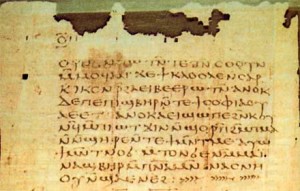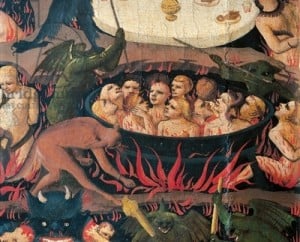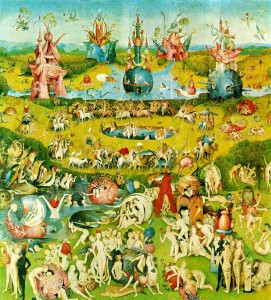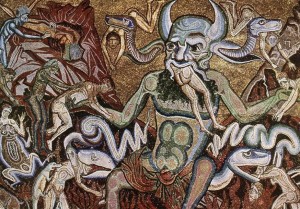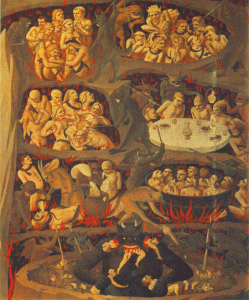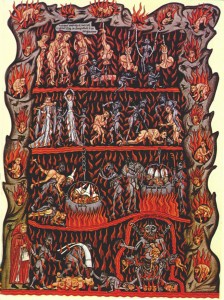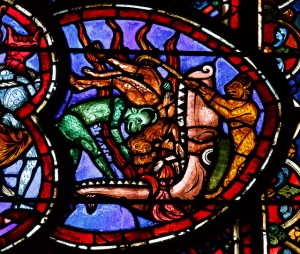At some point in the ninth century, a Christian monk was buried at Akhmim, in Egypt, ancient Panopolis. Portions of several books were laid alongside him, perhaps because they were his particular favorites in life, or else because their visions of the heavenly realms were so appropriate to his passing from this world. This was after all Egypt, where for thousands of years pharaohs had been buried with manuscripts instructing them how to navigate the afterlife. These fragments included portions of 1 Enoch, the Gospel of Peter, and the Revelation of Peter, in Greek.
That burial proved so valuable for later generations because the Revelation (Apocalypse) of Peter would shortly all but vanish from use, leaving few traces. When the grave was rediscovered in the 1880s, the find reintroduced to the scholarly world a text that had been thought wholly lost. Another and very much expanded version in Ethiopic would also be found, including an earlier and fuller text. (As so often, the best source on these matters is J. K. Elliott, The Apocryphal New Testament (Oxford: Clarendon Press, 1993).)
The loss of the Revelation of Peter for so many centuries is startling, when we recall how very popular it had once been in Christian churches around the Mediterranean world, and especially in Egypt and Palestine. For centuries, the two Revelations of Peter and John had both been debatable candidates for inclusion in the New Testament canon and in church liturgies. In the early Christian centuries, the Revelation of Peter was widely cited, and it influenced many other popular texts, including the Acts of Perpetua, the Sibylline Oracles and the Apocalypse of Paul (Visio Pauli). Particularly important in terms of its impact was the Sibylline material, as the second Sibylline gives a lengthy summary of the Revelation of Peter in Greek verse. These Oracles continued to be highly popular throughout the Christian Middle Ages.
By the fifth century, though, the two Revelations experienced very different fates. John’s Revelation succeeded, at least in the church’s Western territories. Today, it survives in hundreds of millions of copies of the Bible worldwide, including in several million hotel nightstands. Peter’s, in contrast, effectively disappeared after the Early Middle Ages, although scattered references surface through the thirteenth century.
This example shows that alternative scriptures and texts could vanish when they lost church approval, even if they contained nothing viewed as grossly heretical.
Yet having said that, the fact that the text itself was unknown assuredly did not mean that its influence disappeared. Through the works that it inspired and which quoted from it, this “lost” apocalypse contributed mightily to shaping the imagination of medieval and early modern Europe, and that impact lingers today.
Peter’s Apocalypse was written in the early second century, probably in Egypt, and perhaps near the time of the Bar-Kokhba revolt of the 130s. At least, that disaster may have driven the work’s denunciation of false prophets. The scripture is “revealed” by the risen Christ, who describes the wonders of heaven and the atrocities of hell. It draws heavily on Jewish apocalyptic writings, particularly 1 Enoch. Conceivably, it may also have recalled Egyptian ideas about the afterlife.
What is new about Peter’s Revelation is the very sensory conceptualization of heaven and hell, which cries out for the attention of painters and poets. Here is the portrait of heaven:
And the Lord showed me a very great region outside this world exceeding bright with light, and the air of that place illuminated with the beams of the sun, and the earth of itself flowering with blossoms that fade not, and full of spices and plants, fair-flowering and incorruptible, and bearing blessed fruit. And so great was the blossom that the odor thereof was borne thence even unto us.
The portrait of Hell is much more substantial. Although the canonical New Testament certainly discusses the torments of the damned (eternal flames and the worm that dies not) these are not described at any length. Peter, in contrast, supplies lavish details of the appropriate punishments inflicted for sins committed during life:
And some there were there hanging by their tongues; and these were they that blasphemed the way of righteousness, and under them was laid fire flaming and tormenting them. And there was a great lake full of flaming mire, wherein were certain men that turned away from righteousness; and angels, tormentors, were set over them. And there were also others, women, hanged by their hair above that mire which boiled up; and these were they that adorned themselves for adultery. And the men that were joined with them in the defilement of adultery were hanging by their feet, and had their heads hidden in the mire, and said: ‘We believed not that we should come unto this place.’ …. And other men and women were being burned up to their middle and cast down in a dark place and scourged by evil spirits, and having their entrails devoured by worms that rested not. And these were they that had persecuted the righteous and delivered them up.
Women who aborted their children sit up to their necks in a lake of excrement, under the constant gaze of the weeping children whose lives had been cut short.
As a thought experiment, we might imagine what effect the Revelation of Peter might have had if it had been canonized, either alongside John’s Apocalypse or even replacing it. How might Christian doctrine and history have developed differently given a somewhat deviant New Testament? In fact, I can see scarcely a word that might have moved Christian doctrine in any different direction – although just possibly, the very explicit condemnation of abortion might have had its impact.
Little in the account of the afterlife would surprise anyone who knows Dante’s Divine Comedy, or the history of Christian art more generally, with all its images of demons and post-mortem tortures.
But that in itself is a remarkable statement. If these medieval artists did not know Peter’s Revelation directly, why do they echo it so faithfully? As we have seen though, Peter inspired other writings, especially the third/fourth century Apocalypse of Paul, and thus became the source of a wildly influential tradition. Dante himself was well read in such apocryphal scriptures, including the Sibyllines and the Vision of Ezra, and tapped into these sources.
The more we know of that ancient apocalyptic current, the more familiar Dante becomes. In the Apocalypse of Paul, typically, a holy figure receives a tour of Hell, and repeatedly asks his spiritual/angelic guide, “Sir, who are these who are suffering?” and is told “These are they who have committed the sin of…” Through the Middle Ages, that influence continued: in the ninth century, for instance, memories of the Apocalypses of both Peter and Paul shaped the Greek “Apocalypse of the Virgin,” yet another circuit of Hell.
However completely a text seems to have disappeared, its words and images survived and flourished, provided they met a powerful popular need.


